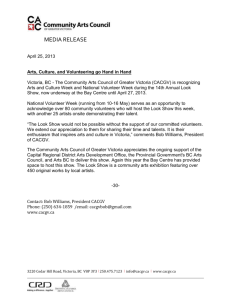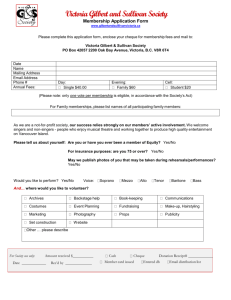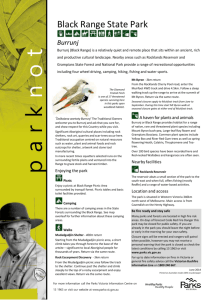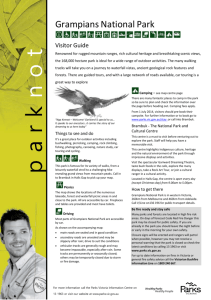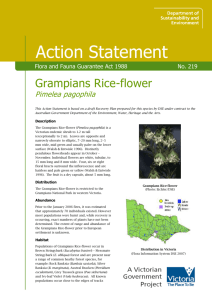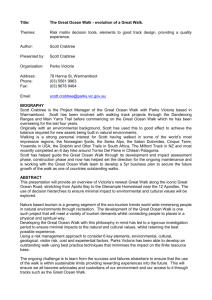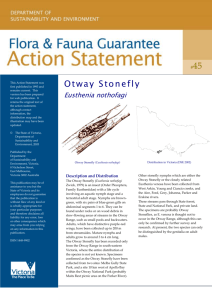From penguins to Apostles, it`s easy to get back to
advertisement
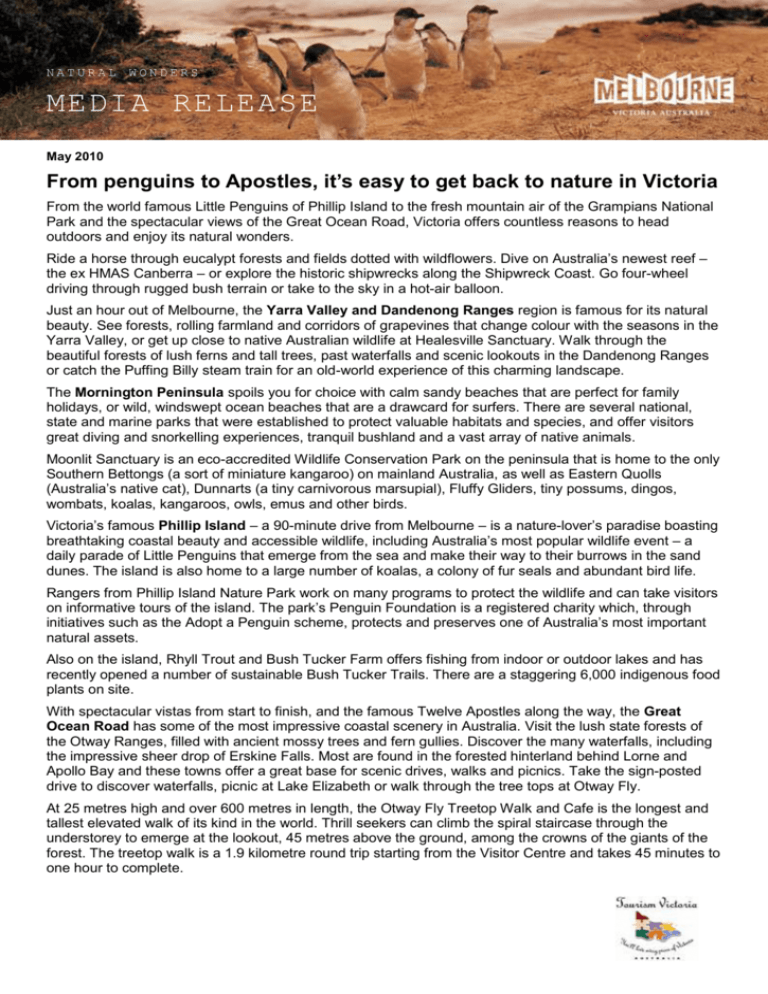
NATURAL WONDERS MEDIA RELEASE May 2010 From penguins to Apostles, it’s easy to get back to nature in Victoria From the world famous Little Penguins of Phillip Island to the fresh mountain air of the Grampians National Park and the spectacular views of the Great Ocean Road, Victoria offers countless reasons to head outdoors and enjoy its natural wonders. Ride a horse through eucalypt forests and fields dotted with wildflowers. Dive on Australia’s newest reef – the ex HMAS Canberra – or explore the historic shipwrecks along the Shipwreck Coast. Go four-wheel driving through rugged bush terrain or take to the sky in a hot-air balloon. Just an hour out of Melbourne, the Yarra Valley and Dandenong Ranges region is famous for its natural beauty. See forests, rolling farmland and corridors of grapevines that change colour with the seasons in the Yarra Valley, or get up close to native Australian wildlife at Healesville Sanctuary. Walk through the beautiful forests of lush ferns and tall trees, past waterfalls and scenic lookouts in the Dandenong Ranges or catch the Puffing Billy steam train for an old-world experience of this charming landscape. The Mornington Peninsula spoils you for choice with calm sandy beaches that are perfect for family holidays, or wild, windswept ocean beaches that are a drawcard for surfers. There are several national, state and marine parks that were established to protect valuable habitats and species, and offer visitors great diving and snorkelling experiences, tranquil bushland and a vast array of native animals. Moonlit Sanctuary is an eco-accredited Wildlife Conservation Park on the peninsula that is home to the only Southern Bettongs (a sort of miniature kangaroo) on mainland Australia, as well as Eastern Quolls (Australia’s native cat), Dunnarts (a tiny carnivorous marsupial), Fluffy Gliders, tiny possums, dingos, wombats, koalas, kangaroos, owls, emus and other birds. Victoria’s famous Phillip Island – a 90-minute drive from Melbourne – is a nature-lover’s paradise boasting breathtaking coastal beauty and accessible wildlife, including Australia’s most popular wildlife event – a daily parade of Little Penguins that emerge from the sea and make their way to their burrows in the sand dunes. The island is also home to a large number of koalas, a colony of fur seals and abundant bird life. Rangers from Phillip Island Nature Park work on many programs to protect the wildlife and can take visitors on informative tours of the island. The park’s Penguin Foundation is a registered charity which, through initiatives such as the Adopt a Penguin scheme, protects and preserves one of Australia’s most important natural assets. Also on the island, Rhyll Trout and Bush Tucker Farm offers fishing from indoor or outdoor lakes and has recently opened a number of sustainable Bush Tucker Trails. There are a staggering 6,000 indigenous food plants on site. With spectacular vistas from start to finish, and the famous Twelve Apostles along the way, the Great Ocean Road has some of the most impressive coastal scenery in Australia. Visit the lush state forests of the Otway Ranges, filled with ancient mossy trees and fern gullies. Discover the many waterfalls, including the impressive sheer drop of Erskine Falls. Most are found in the forested hinterland behind Lorne and Apollo Bay and these towns offer a great base for scenic drives, walks and picnics. Take the sign-posted drive to discover waterfalls, picnic at Lake Elizabeth or walk through the tree tops at Otway Fly. At 25 metres high and over 600 metres in length, the Otway Fly Treetop Walk and Cafe is the longest and tallest elevated walk of its kind in the world. Thrill seekers can climb the spiral staircase through the understorey to emerge at the lookout, 45 metres above the ground, among the crowns of the giants of the forest. The treetop walk is a 1.9 kilometre round trip starting from the Visitor Centre and takes 45 minutes to one hour to complete. The best known attraction on the Great Ocean Road is the Twelve Apostles. The remnants of constant erosion of the mainland’s limestone cliffs, which began up to 20 million years ago, the giant rock stacks rise majestically from the Southern Ocean and are the central feature of the rugged Port Campbell National Park. Parks Victoria has built boardwalks, tracks, and viewing areas to guarantee spectacular views of the Twelve Apostles and there are stairs to the beach at Gibson Steps and Loch Ard Gorge. The Great Ocean Walk has been designed by Parks Victoria for walkers of all abilities and ambitions. The walk links Apollo Bay to the Twelve Apostles passing through the Otway and Port Campbell National Parks. The Great Ocean Walk stretches 104 kilometres and takes most walkers eight days and seven nights to complete. However it has been designed so walkers of almost any ability can “step-on and step-off” the trail. There are short walk options, ranging from six to 15-kilometres in length, and walkers can either camp along the route or “step off” for more comfortable accommodation options in a range of hotels, B&Bs and luxury lodges. Victoria’s Grampians region offers an abundance of adventure activities, superb national and state parks and a diverse array of native wildlife. Located three hours’ drive west of Melbourne, the region offers stunning vistas and unspoiled natural beauty. It has a diverse range of flora, including sub alpine forest, shrub woodland and heathlands. The Grampians region is one of Victoria's main centres for rock climbing and abseiling, offering a range of climbs including the internationally renowned Mount Arapiles. Other popular outdoor activities include fishing and boating in the region's inland lakes and rivers. National parks in the region are a haven for birds, with nearly 45 per cent of Victorian bird species found here. The Little Desert and Wyperfeld national parks are home to the Mallee Fowl, one of the few birds in the world to build a mound for its eggs. Kangaroos, bandicoots, emus and reptiles are also plentiful. And don’t miss Brambuk, the National Park and Cultural Centre, where visitors can learn about local Aboriginal culture and pick up information about the Grampians National Park. Aboriginal people have a long association with the Grampians and there are many places in the park where you can see ancient rock art including Billimina Shelter, Gulgurri Manja Shelter, Manja Shelter and Ngamadjidi Shelter. In the High Country region to the north-east of Melbourne try abseiling and rock climbing at the Cathedral Ranges and ride the rapids of the Big River Valley. At Mansfield, take a four-wheel drive tour of the historic cattleman’s huts or mount a horse and ride the country trails. Stop to catch fish at the Howqua River and barbecue your catch. Mount Hotham is a great skiing and snowboarding destination and is quickly becoming a summer adventure playground too. Go bushwalking and explore the Razorback on the way to the majestic Mount Feathertop. Alternatively try mountain biking on some of Victoria’s most beautiful tracks, which wind through snow gums and alpine grass. Start the day with an adrenalin burst. Media contacts: Emma Miller and Kylie Miller, Senior International Media Officers, Tel: +61 3 9653 9814; Email: internationalpr@tourism.vic.gov.au Corporate website: www.tourismvictoria.com.au Consumer website: www.visitmelbourne.com



